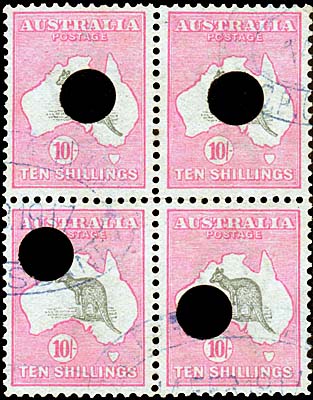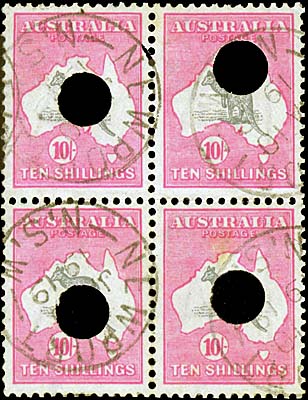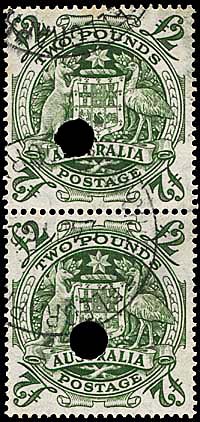Punctures in stamps.
- Australia 1901-1988
- New South Wales
- Queensland
- South Australia
- Tasmania
- Victoria
- Western Australia
- International
- Special aspects
There are two types of punctures in Colonial and Australian stamps and they served very different purposes:
- punctures in stamps issued by Western Australia;
- punctures issued by the Commonwealth of Australia from 1913 in terms of shape and size on :
Kangaroo on Map;
Coat of Arms;
Robes;
Sydney Harbour Bridge;
Navigators (pre-decimal). - Forgeries and fakes.
Western Australian Imperial punctures.
A large number of Swans are known with small punctures - either 3 mm or 4 mm in diameter.
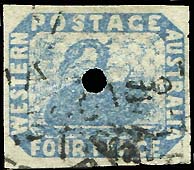 |
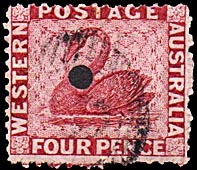 |
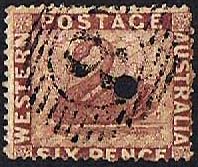 |
| 4d blue Swan with 3 mm puncture. | 4d rose Swan with a 3 mm puncture. | 6d brown Swan with 3 mm puncture. |
These punctures are generally referred to as Imperial punctures and they relate to Official Correspondence in Western Australia.
"Commencing on 1 January 1856, stamps for use by Imperial Departments were distributed by the Principal Commissariat Officer. From
1 August 1862, stamps for these Departments were identified by a hole punched near the centre of the stamp. This practice continued until March 1886 when the Departments were transferred to Colonial Government control. The Imperial Departments were:Commissariat, Convict, Lunatic, Military, Chaplaincy, Invalid, Enrolled Guard, Police and part of the Magistracy".
(Sydney Views, No. 91 May 2006, p.2)
Hence despite the claims made by sellers on sites like Ebay as well as some smaller foreign auction houses, these punctured stamps have nothing to do with telegrams.
The Post and Telegraph Act of 1901 required the costs of all telegrams to be pre-paid with postage stamps. This had already been the practice in New South Wales and Victoria and, at least to some extent, in Queensland and Tasmania.
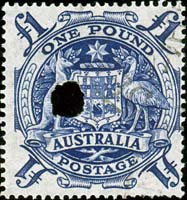 |
As the Postmaster-General's Department became more involved in management of telegraph affairs and procedures, administrative regulations required that the transmission forms were to be returned after transmission (i.e. daily) to the Chief Telegraph Office in the respective State.
There they would be accounted for and the procedure was introduced for high value stamps (5/- and over) to be defaced with a puncture. The defacing was intended to make the stamp unattractive to collectors or to those wishing to defraud the Post Office. There were quite severe penalties attached to taking these stamps. The puncturing was not to interfere with the date of lodgement. |
The system of daily returns continued to operate until the 1950s when Postmasters were required to keep the forms secure for 12 months and then "destroying them by fire". In 1979, the puncturing requirement was raised to stamps of face value of $1 or more.
Cash registers, which had been introduced in 1914, were permitted to be used from the issue of the first transmission forms in 1918
(see AB-TO-1). They finally gained acceptance and took over from the use of stamps and so the use of high denomination stamps reduced significantly.
Punctures were also used on stamps used to pay telephone accounts. They can however be distinguished by having roller cancellations.
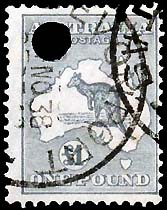 |
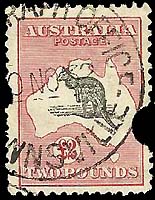 |
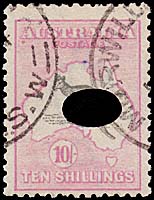 |
Punctures were normally round although shape depended on the sharpness of the hole punch, any double punching and on the concentration of the junior clerk who was often assigned this task. Consequently the punctures could be elliptical or could have very ragged edges or could appear anywhere on the stamp. |
| £1 grey C of A watermark (used in November 1938) showing 3 mm puncture in top left corner. |
£2 black and red Kangaroo on Map small multiple watermark with 7 mm puncture just touching on both sides. Used at Telegraph Office |
10/- light pink and grey Kangaroo on Map third watermark with 5mm double puncture (so 9 mm wide). Used at Murwillumbah, NSW. | |
See also: |
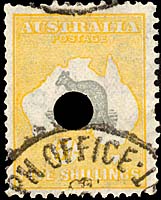 |
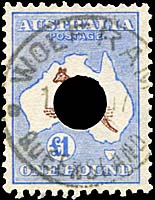 |
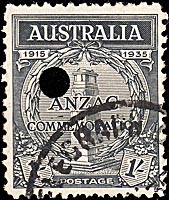 |
The size of the punctures also varied:
|
| 5/- yellow and black Kangaroo of Map C of A watermark used with a 5 mm puncture at C. T. O. Hobart. |
£1 Kangaroo on Map 3rd watermark used with a Queensland 7 mm puncture in 1917. | 1/- Anzac Commemorative with a 4.5 mm puncture and a 1935 TELEGRAPHS cancellation from a place unknown :-( |
Examples of punctures are:
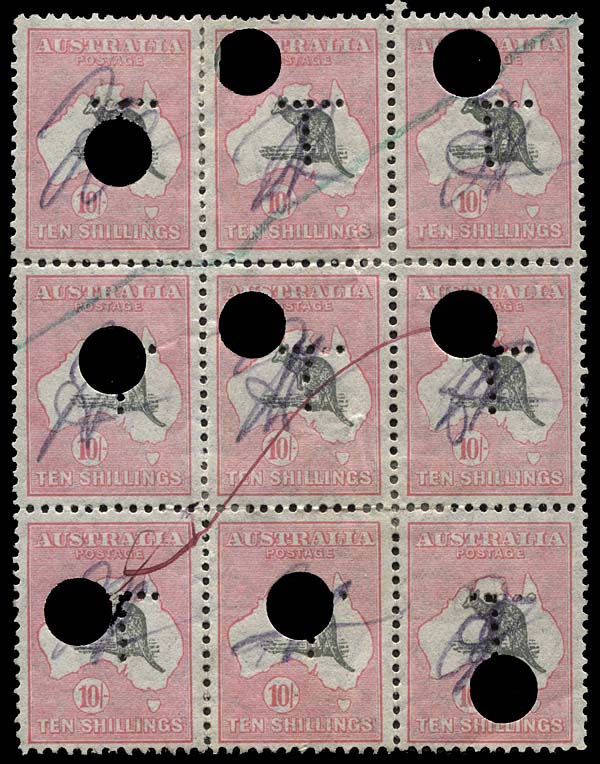 Provenance: Clemente, Johnstone. Tasmanian Stamp Auctions December 2016. |
A most remarkable and unique block of 9.
10/- grey-black and rose-crimson Kangaroo on Map printed on C of A watermarked paper. Characteristics:
The record multiple for this stamp with these two characteristics. |
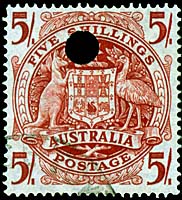 |
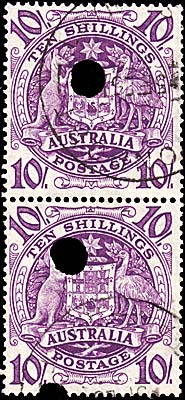 10/- purple Coat of Arms (ACSC # 269). C of A watermark. Used at Devonport 5 February 1951. 5 mm puncture. |
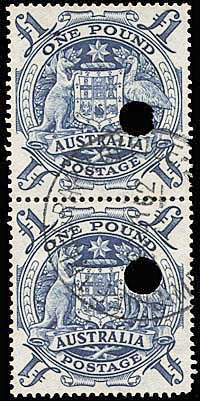 £1 blue Coat of Arms (ACSC # 270) C of A watermark. 5 mm puncture. Used at Chief Telegraph Office Melbourne, 20 July 1962. |
5 mm puncture. Used at Chief Telegraph Office Melbourne, 24 July 1962. |
5/- carmine Coat of Arms 5 mm puncture.
|
|||
| See also: Devonport (1955); |
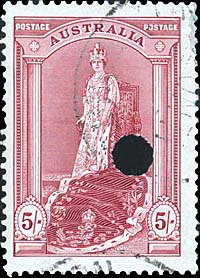 |
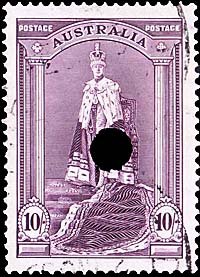 |
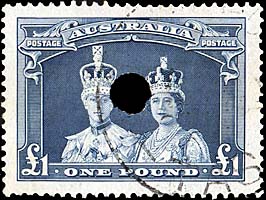 |
5/- dull lake Coronation Robes 5 mm puncture. |
10/- purple Coronation Robes 5 mm puncture. |
£1 dull blue Coronation Robes (ACSC # 216) 5 mm puncture. |
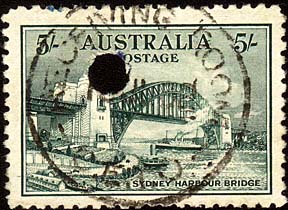 |
5/- green Sydney Harbour Bridge.
5 mm puncture. Has RECEIVING ROOM / Very scarce. Probably only three examples exist. Prestige Philately 2008 Rarities Sale 136 Lot 121. |
.jpg) |
| Use of the 5/- Dampier Navigator on Transmission form AA-TO-12Bc at Brisbane Airport with date stamp of 26 August 1965 and the Navigator stamp is punctured. |
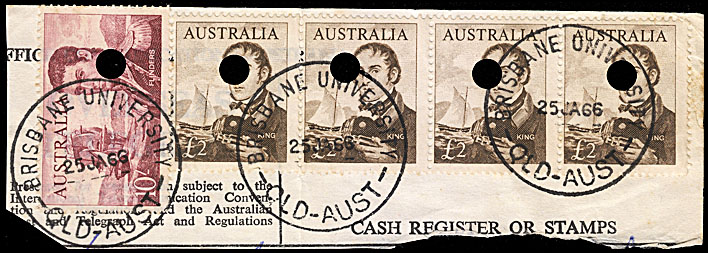 |
Use of 10/- Flinders and £2 King from the pre-decimal Navigators set all punctured. Brisbane University, Queensland used on 25 January 1966 - nearly 3 weeks before the change to decimal currency. Used on telegram piece. |
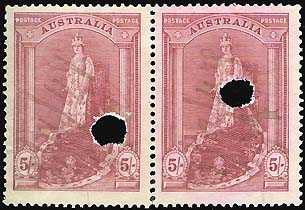 |
There are a number of sellers who market stamps with punctures which are either forged or of dubious value. Sometimes holes are added in a very rough way which does not reflect the type of hole which was made. The Robes pair at left has a type of manuscript cancellation with two holes of different shape and size. If the stamps had been on a telegram, the holes would have been much more similar - such as those on the Kangaroo on Map multiples and on the 10/- Arms pair above.
Other possible fakes are stamps with "repaired holes". Although there may have been some attempt by one or two clerks to keep the punched out pieces and illegally put them back in place later, there are far to many examples which have been "artificially created". These items should all be avoided on all grounds. |
